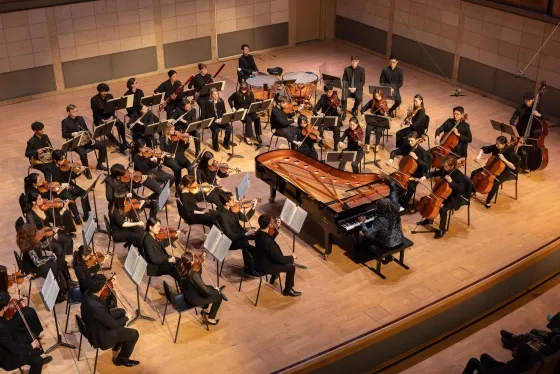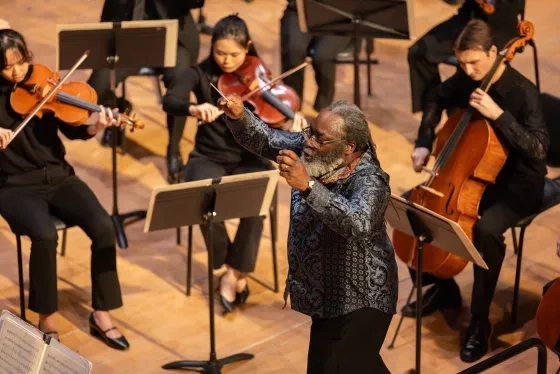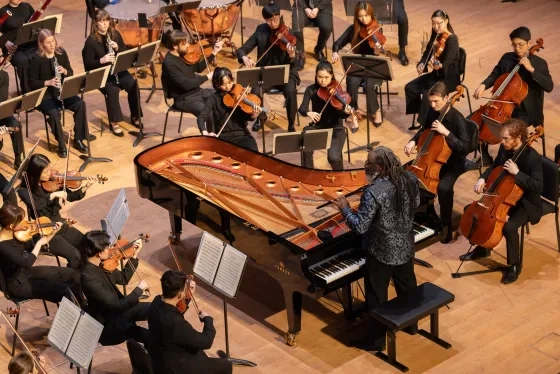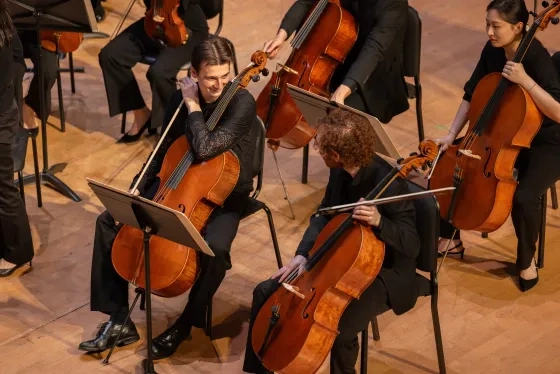How Awadagin Pratt Led Beethoven from the Piano with SFCM's Chamber Orchestra
Pratt played and conducted Beethoven in April for his first performance with the SFCM Chamber Orchestra.
If anyone wanted to make a Beethoven piano concerto harder, one of the logical suggestions might be, “Well, you could conduct it, too.”
That’s just what SFCM piano faculty Awadagin Pratt did in April for SFCM’s spring Chamber Orchestra at-capacity performance, the second half of which saw Pratt play and conduct Beethoven’s Overture to Egmont, Op. 84, as well as the composer’s Piano Concerto No. 3 in C Minor, Op. 37.
“This is something that I've done several times over the years, although it's been a couple years since the last time,” Pratt says. “And the challenge is really in training the orchestra: You start off by focusing on the sound and articulation and length of notes that you want them to execute when you're playing, because I can't show those things while I'm playing.”
One double-edged sword of conducting from a piano is simply hearing the subtleties of an ensemble over the sound of the concert grand piano that you’re playing—in this case, with the lid removed to facilitate eye contact with the ensemble. In fact, it can be more tricky once an orchestra is locked in to the soloist’s sound, akin to how playing truly in time with a metronome means you often can’t hear the metronome over your own sound. “The chamber orchestra was playing right with me, and I said to them at some point, ‘I can't hear you, which is a good thing, because it means we're together.’”
There are other practical considerations from the staging side of things as well. “There’s a lot being done with eye contact,” Pratt says, “because in this piece there are specific moments of the soloist with solo instruments or smaller duos and trios, like flute and bassoon. The strings are right next to me, so they can see my fingers go down onto the keys, but the bassoon and flute can’t. You’re coordinating bow strokes with the breath of the wind instruments and with my fingers, and sometimes there might be a micro-fraction of a delay with the winds than it would be if they were right next to me.”
Pratt performed the concerto in El Paso, Alabama, and Indianapolis in January alone, and was impressed with how the students measured up against professional ensembles, along with the way they were able to have the give-and-take chemistry that makes great performances. “In the second movement of the Beethoven concerto, there's basically a trio with piano, flute, and bassoon,” he explained. “I'm the accompanying line at that point, they're the soloists. So within the framework if they stretched something, I just accommodated it without discussing it. I didn't say, ‘I'm gonna do this’ or ‘we're gonna do this.’ It's just what evolved naturally.”
“The receptiveness, responsiveness, and engagement of the students was great,” he adds. “It was nice to be looking up during the concert and seeing smiles on their faces. Some of my friends were there and they said afterwards, ‘We were watching them smile while watching you play.’ That's a cool thing: the audience enjoying watching the students enjoy the experience.”
As for future collaborations with SFCM ensembles like the April performance, Pratt says he’s looking forward to doing more. “The feedback we got from the students was great, and I enjoyed working with them with that sort of evolution the piece takes over a couple of weeks.”
He adds, “It's funny, because, you know, I teach piano here, obviously, and I see these kids all the time, so now it's nice to know who they are, what they play. Now I say hello, and I know who I’m talking to.”
Learn more about studying piano at SFCM.




